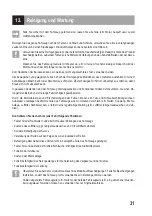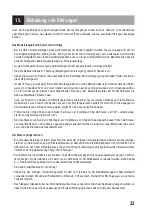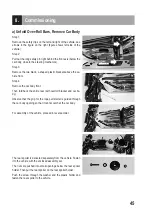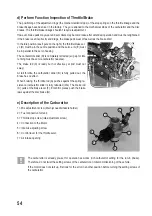
42
b) Engine & Fuel
• Pay attention to the running-in regulations for the engine as well.
• Use only suitable methanol/oil based model fuel (5% - 25% nitromethane and 16% synthetic oil). Never use conven
-
tional vehicle gas of mixtures of it! Also, never use fuel for flight models. It contains too little oil.
• Keep the fuel locked away, store it inaccessibly to children. Only keep the fuel in well ventilated rooms. Only store
permissible amounts.
The fuel is highly combustible; the fuel vapours are highly explosive! Never smoke when handling fuels (e.g.
when fuelling up). Keep away naked flame and other ignition sources! Danger of explosion and fire!
• Avoid contact with eyes, mucous membranes and skin. Danger to health! Consult a doctor immediately if you feel
unwell!
• Observe the safety datasheet information on the fuel. The safety datasheet will be available from the manufacturer
or seller of the fuel (e.g. online).
The safety datasheet contains important information on storage, transport, fire and also for medical care after
emergencies.
We recommend always taking along the safety datasheet when handling fuels.
• Never spill the fuel. Use a special fuel bottle to fuel the car. Spilling fuel will not only damage the environment; there
also is a danger of explosion and fire!
• Check the tightness of hose connections and tank lid before every use.
• Test-runs or drives must only take place outdoors. Do not inhale the fuel and exhaust fumes; they are hazardous to
health!
• If driving operation is permanently terminated, the fuel remaining in the model tank must be pumped out. Only
transport the model when the tank is empty! Empty the tank if you do not use the model for several days.
• Only use appropriate containers for transporting the fuel.
• The fuel can eat away and damage varnish and rubber parts.
• Empty fuel containers as well as remaining fuel must be disposed of as hazardous waste.
c) Driving
• Check the vehicle for damage before every run; replace worn tyres.
• Check all screw connections and attachments before and after each run, as these may come off or loosen due to
engine vibrations during driving.
• The range of the transmitter decreases when the batteries (or rechargeable batteries) are weak. Weak batteries (or
rechargeable batteries) in the receiver system prevent powerful operation of the sensor. Before going on a drive,
check the charge condition of the batteries or rechargeable batteries in the transmitter and receiver.
Check the receiver power supply before and after every drive. If the voltage is too low, the servos will only show
weak reactions, so that the vehicle will no longer react to the control commands from the transmitter. The receiver
may also show unpredictable responses.
Terminate driving operation at once (switch off motor, switch off receiver power supply, switch off transmitter) if the
reaction of the receiver system is not as desired. Then replace the batteries/rechargeable batteries or recharge
rechargeable batteries.
Содержание 490150
Страница 142: ...142 ...
Страница 143: ...143 ...
















































